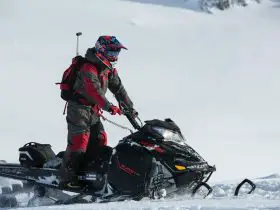Are you planning a snowmobiling trip soon and wondering what outfits you should be packing for the big trip? If you don’t stay warm and cozy while on the snowmobile, it is likely you won’t enjoy your snowmobile ride and will end up cutting the trip short. Even if it takes a bit of extra planning, you must choose snowmobile outfits that are meant for frigid temperatures but also for a body that’s in aerobic mode, sweating, and excited. In this article below, we will outline what to wear when snowmobiling.
Table of Contents
What Snowmobile Outfits Should You Be Purchasing
When it comes to snowmobiling, your outfit matters a lot! You know what it’s like when you are trying to enjoy an outdoor winter activity without any warm or waterproof clothes on. It’s a disaster.
So when choosing snowmobile outfits, you need to keep the following things in mind:
- Avoid cotton fabrics
- Layering is your best friend
- Snowmobile suits for the win (and to avoid the wind)
- Snowmobiling gloves help a lot
- Mask or balaclava is a great add-on
- Warm socks in layers and waterproof snowmobiling boots
- Protective goggles and a safety helmet to protect your noggin
- Hand warmers to go all out
It’s not easy outfitting a snowmobiler, but once you have these items you are set for life. Let’s look at them in detail below.
Avoid Cotton Fabrics When Snowmobiling
You might have lots of cotton fabrics in your closet because they keep you cool when it’s warm outside and it’s a natural fabric that breathes. But when it comes to snowmobiling outfits, cotton is a big no-no.
Cotton tends to absorb moisture which will keep you cold. This is absolutely the worst when it comes to snowmobiling in parks with below-zero temperatures.
Think about using silk, polyester, or other materials like that which will keep you dry, warm, and cozy. Some materials made for snowmobiling and other outdoor winter activities wick moisture away from your body, and thus, allow your body to keep its warmth, rather than losing it all in the first twenty minutes of activity.
With the proper snowmobile outfit in place, you will be able to go all day long on your snowmobiling trip, rather than having to cut it short after a couple of hours, because you are freezing!
Dress in Layers on a Snowmobile
You don’t want to wear a bulky jacket with just a t-shirt underneath when on a snowmobile ride, no matter how expensive or warm your jacket might be. Layering is the name of the game here.
Always start with a moisture-wicking underlayer, then add 3-5 layers on top as you see fit. Tight underlayers might prevent your body from breathing freely. But loose layers won’t contact your body close enough to wick away moisture.
It takes a bit of trial and error to figure out what will work best for your body. Also, keep in mind that the colder it is, the more layers you will need to stay warm and cozy.
Each time the temperature drops by 10 degrees Celcius, you will need another layer added in with a thicker jacket on top and more.
Wear a Snowmobile Suit
Snowmobile suits comprise of a pair of pants and a jacket to wear over the pants. They are made of special materials like Goretex and acrylic that are waterproof and don’t absorb moisture from the outside. This ensures that you don’t have to worry about being a wet, and cold mess after your snowmobile ride.
They are also windproof, which means that you won’t feel that wind biting through your body no matter how much the windchill factor drops.
High-quality snowmobile suits are made for warmth retention and are a necessary component of any snowmobile outfit.
Wear Warm Snowmobiling Gloves That Grip
Your fingers are going to be working extra time when you are on your snowmobiling trip. That’s why it’s important to keep them warm. A good pair of gripping gloves will keep your fingers toasty and prevent them from slipping off your snowmobile handles while you are cruising around at high speeds.
Try different-sized gloves on to ensure you get the right fit for you, otherwise, you won’t have a proper grip on your snowmobile and it will ruin your trip. Also, don’t think leather gloves or some other gloves will do just fine – you need gloves made for snowmobiling otherwise, they won’t be waterproof, windproof, or have a good enough grip.
Don’t Forget a Mask or Balaclava
When you are speeding away on your snowmobile through beautiful landscapes, the wind can be fast enough to bite through your bones (or at least it will feel like that). That’s why any part of your body that’s exposed to the wind or elements will feel chilled and could even get frostbitten.
Choose fabrics like fleece or polyester for your face mask or balaclava because they will allow you to breathe freely and will wick away moisture, keeping you warm and dry. You might not be used to wearing a balaclava at first, but you will find soon enough that you won’t be able to go without it.
Wear Warm Socks and Waterproof Boots
Of course, you are thinking warm socks are a must. BUT, you might not know that you need to wear socks in layers as well!
Think wool, silk, fleece, or other synthetic fabrics when choosing your socks. Use a water-wicking sock for the underlayer and a fleecy warm one for the top layer.
You will also need waterproof boots to ensure your feet stay warm and cozy. When you are trying out boots at your local snowmobiling outfitting store, ensure that your feet along with all the layers of socks fit into the boots. You don’t want to have boots that feel too tight with your sock layers, because that will pinch your feet and distract you from your snowmobiling trip.
Also, remember that your boots will need to protect you from impacts, in case you are a bit too rough on your ride (as it is an adventure of sorts). Good waterproof snowmobile boots have a breathable liner to keep off perspiration and are made of rubber and other waterproof materials.
Wet feet that hurt are the worst when snowmobiling, so put in some extra time and money and get a pair of good waterproof boots. It’s worth it!
Protective Goggles and a Safety Helmet Are a Must When Snowmobiling
It is inevitable as you ride around on your snowmobile that snow, ice, insects, and other debris will fly around because that’s how rough the ride will be. You can’t prevent that. But you can protect yourself from the flying snow and debris, and particularly your eyes from it, by wearing protective goggles.
Also, if the day is very bright then the darker lenses will protect your eyes from the harsh rays of the sun, and allow you to have proper visibility. On darker days, you can use lense colors like rose, amber, or blue.
If you have a face helmet with a face shield, you won’t need goggles.
Also, if you have a snowmobile with a windshield, then this can protect you from flying snow and debris as well. Windshields are also great because they increase the aerodynamic nature of the snowmobile reducing air drags, thus, allowing you to move faster. If speed is your thing, try to get a snowmobile with a windshield.
Don’t forget your helmet as this will protect you from injuries in case of impact. Some snowmobile helmets will have a face shield as well, so you might not need to have extra goggles in place. Also, ensure you buy a proper snowmobile helmet that is the right size for you because it will allow air circulation and help your head retain heat.
Keep the helmet straps tied tight and don’t forget to check for the DOT symbol on the helmet to ensure it’s reliable.
Hand Warmers for That Extra Comfort
There are many different kinds of hand warmers on the market, like battery-powered, air-activated, and supersaturated solution hand warmers. Try different ones and see what works for you and your warmth level.
Maybe gloves are enough for you. But if they are not, then hand warmers can ensure your hands stay warm and toasty, no matter how long you have been out on your snowmobile.
The average battery-powered hand warmers can keep your hands warm for 6 hours before needing recharging. Whereas the air-activated ones are disposable and can keep your hands warm for 10 hours. The supersaturated ones can be used a couple of times before needing disposal, and work on the same principle as the air-activated ones.
You can also adjust the heat you want on your hands with the battery-powered hand warmers, so if you get particularly cold, then these would be a good one for you to use.
What To Wear When Snowmobiling: It’s Complicated
It might seem like choosing snowmobile outfits is complicated, but it’s truly not. In the beginning, you might be confused about what to wear when snowmobiling. But as you get accumulate gear and outfits, you will figure out what your body preference is and what keeps you warm and what doesn’t.
It’s all about personal preference when it comes to choosing snowmobile outfits. That’s why there are no one-size-fits-all outfits that can be sold in the stores. It would be so easy if that were the case.
Click to learn more about how to store a UTV in wintertime.









